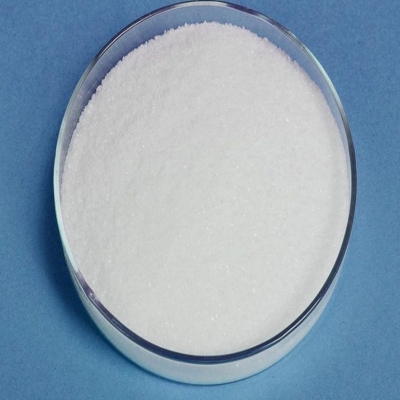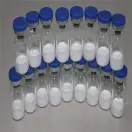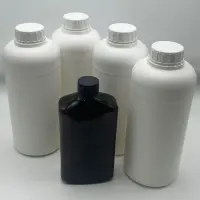-
Categories
-
Pharmaceutical Intermediates
-
Active Pharmaceutical Ingredients
-
Food Additives
- Industrial Coatings
- Agrochemicals
- Dyes and Pigments
- Surfactant
- Flavors and Fragrances
- Chemical Reagents
- Catalyst and Auxiliary
- Natural Products
- Inorganic Chemistry
-
Organic Chemistry
-
Biochemical Engineering
- Analytical Chemistry
- Cosmetic Ingredient
-
Pharmaceutical Intermediates
Promotion
ECHEMI Mall
Wholesale
Weekly Price
Exhibition
News
-
Trade Service
If the results of these new studies are positive, it will support the approval of zuranolone for PPD, a short course of treatment for acute treatment of MDD, and continuous treatment of MDD on demand
.
The first is the Waterfall study, which is evaluating zuranolone's 2-week regimen for the treatment of MDD, and the results are expected to be available in the first half of this year
.
The Shoreline study covers indications for on-demand treatment and obtained preliminary data for the 30mg dose group in October last year.
The final readings will be announced around the middle of the year
.
The Skylark study is studying a two-week course of 50mg for PPD, and plans to report the results in the second half of this year
.
It will also report the results of the 50mg cohort study from the Shoreline study and another phase 3 trial of acute MDD called Coral
.
04 CRISPR Therapeutics/Vertex gene editing therapy CTX001
CRISPR Therapeutics and Vertex have obtained some data from the phase 1/2 trial of gene editing therapy CTX001 for the treatment of sickle cell disease (SCD) and β-thalassemia, but the big data points of the drug's heavy potential should appear this year
.
Early results from the CLIMB-111 study for the treatment of thalassemia and the CRIMB-211 study for the treatment of sickle cell disease have been announced, showing encouraging signs of fetal hemoglobin levels and clinical goals, reducing sickle cell painful episodes and The dependence of thalassemia patients on blood transfusions
.
However, they also raised questions
.
The most important thing is whether these effects are long-lasting and whether they support CTX001 as a potential cure for sickle cell disease and thalassemia
.
Previous data showed that some patients' hemoglobin levels declined over time, which may raise questions about whether CTX001 can be used as a one-time treatment
.
At the same time, safety is a long-term issue
.
Serious adverse reactions occurred during the treatment, although these were mainly related to the bone marrow-destructive treatment required before stem cell transplantation
.
CRISPR and Vertex may be defeated by Bluebird Bio in entering the US market
.
Currently, Bluebird Bio’s gene therapy Zynteglo has been approved in the European Union to treat thalassemia.
The company originally planned to apply for the same indication in the United States this year, but safety concerns in the sickle cell disease trial led to Zynteglo’s marketing and sickle.
The cell disease test was put on hold
.
This delay provides an opportunity for CRISPR and Vertex to seize the opportunity in the competition, but only if the data from the two trials support the effectiveness, safety and durability of CTX001
.
If this is the case, analysts at Jefferies, a well-known investment bank, believe that the peak annual sales of CTX001 may exceed $1 billion
.
05 Iovance tumor infiltrating lymphocyte (TIL) therapy lifileucel
Another eagerly anticipated clinical data this year comes from Iovance’s cell therapy lifileucel (formerly known as LN-144).
The company hopes that this first-in-class cell therapy can obtain CAR-T therapy in the treatment of solid tumors.
The treatment of hematological tumors is as impressive as the efficacy data
.
Lifileucel is a tumor infiltrating lymphocyte (TIL) therapy, which originated from the research of the National Cancer Institute in the United States
.
It follows a similar protocol to CAR-T: lymphocytes are collected from the body, exposed to interleukin-2 (IL-2) to promote their growth and activate them, and then infused back into the patient to fight cancer
.
However, unlike CAR-T, TIL does not require genetic modification, and genetic modification will cause some problems related to patent protection
.
The excitement of Lifileucel is that it has the potential to target solid tumors, while CAR-T is not yet effective in treating solid tumors
.
Iovance is pursuing some major cancer indications: the company is conducting a mid-term clinical trial of lifileucel and evaluating its successor product LN-145 to treat melanoma, head and neck cancer, and non-small cell lung cancer that have been treated with PD-1 checkpoint inhibitors.
(NSCLC) and cervical cancer
.
Previously, LN-145 has obtained a breakthrough drug qualification from the US FDA for the treatment of advanced cervical cancer patients who have progressed during or after chemotherapy
.
The company might have submitted an application for melanoma indications later this year
.
However, this timetable was delayed due to questions about the best way to determine the titer of TIL
.
At the last reading, lifileucel achieved an objective remission rate of about 35%.
After 28 months of follow-up, the median remission time has not yet been reached
.
The possibility of extending cell therapy to solid tumors has caused industry speculation.
Iovance may be an acquisition target, and both Takeda and Gilead Sciences have been mentioned as possible acquirers
.
However, the delay in submitting the application of Lifileucel is likely to temporarily inhibit the enthusiasm of any interested parties
.
So far, Iovance stated that its TIL product manufacturing success rate has exceeded 90%, but the economic potential and patentability of TIL are still in doubt
.
The bullish supporters believe that these problems will be resolved, and the data so far indicate that lifileucel has the potential to gain blockbuster sales
.
06 Bristol-Myers Squibb deucravacitinib
Currently, the psoriasis market is becoming more and more crowded, but many of the new therapies that have made progress in the past few years are antibody drugs, which means administration by injection
.
This is one of the reasons why people have high hopes for Bristol-Myers Squibb's (BMS) oral TYK2 inhibitor deucravacitinib (BMS-986165).
The final results of the drug's phase 3 trial will be carefully reviewed in the next few weeks
.
Deucravacitinib does have some oral drug competitors, especially Amgen's PDE4 inhibitor Otezla (apremiast).
The drug was developed by Xinji, but it had to be sold as an antitrust regulatory requirement for the US$74 billion acquisition of BMS
.
Data from a phase 3 trial reported in November last year showed that deucravacitinib is superior to Otezla in removing skin lesions in patients with moderate to severe plaque psoriasis, and seems to be at the same level as injections, which is an advantage for BMS
.
In addition, the November test data also supports TYK2 as an effective target for inflammatory diseases, which is an intracellular kinase involved in the signal transduction of cytokines such as IL-23, IL-12 and type I interferon.
Cytokines are thought to play a role in inflammation and immune response
.
However, Pfizer’s TYK2 inhibitor PF-06826647 will also bring additional competition, and the phase 2 clinical trial data of the drug will be announced soon
.
Even so, BMS is still in a leading position, and analysts at Evaluate, a pharmaceutical market research organization, predict that in 2026, sales of deucravactinib may reach nearly $1.
9 billion
.
The full data of the Poetyk-PSO-1 study will be reported at this year's medical conference, and the results of the 1,000-patient Poetyk-PSO-2 trial will also be reported in the coming weeks
.
So far, the safety of this drug has not been seen much
.
At the same time, BMS or its academic partners are also testing deucavitinib in interim studies of ulcerative colitis, Crohn’s disease, systemic lupus erythematosus and psoriatic arthritis
.
Among these therapeutic indications, the success of any one indication may expand the long-term commercial potential of deucravacitinib
.
07 AstraZeneca/Daiichi Sankyo ADC drug Enhertu
AstraZeneca has paid a lot of money for Daiichi Sankyo in co-development of the anti-HER2 antibody conjugate (ADC) Enhertu (trastuzumab deruxtecan)
.
If you want to reach billions of dollars in sales expectations and get a good return on investment, you will need this drug to achieve its goals in a wide range of uses
.
Currently, Enhertu has been approved by the US FDA for use in HER2-positive advanced breast cancer that has received two or more HER2 drugs
.
Earlier this year, Enhertu received its second approval as a third-line therapy for previously treated HER2-positive gastric cancer, a treatment area not covered by the previous HER2 drug category
.
In recent weeks, Enhertu has achieved positive Phase 2 results in the treatment of HER2-positive non-small cell lung cancer (NSCLC)
.
This created another first, and quickly entered Phase 3 trials
.
If successful, Enhertu will gain a small but very meaningful share of the big market
.
Later this year, AstraZeneca expects to have the results of a Phase 3 trial and a regulatory application to publish Enhertu as a second-line therapy to treat patients with HER2-positive breast cancer and breast cancer patients with low levels of HER2 biomarker expression
.
These so-called "HER2 low-level" tumors contain some cancer cells that express the HER2 protein, which may account for 55% of all breast cancer cases
.
In contrast, HER2-positive tumors account for 15%-20% of all breast cancers
.
In December last year, at the San Antonio Breast Cancer (SABC) Symposium, AstraZeneca and Daiichi Sankyo announced the results of the combination of Enhertu and the BMS checkpoint inhibitor Opdivo (nivolumab), showing some encouraging results
.
Among patients with low levels of HER2, the overall response rate (ORR) was 38%
.
The Phase 2 study of Enhertu combined with hormone drugs in the treatment of early HER2 low-level tumor patients is expected to announce the results in the second half of this year
.
AstraZeneca paid a total of 1.
4 billion U.
S.
dollars to Daiichi San to ensure the rights to the drug.
The total value of the agreement may be as high as 7 billion U.
S.
dollars
.
08 Novartis heart failure drug Entresto
Novartis Entresto (sacubitril/valsartan) was approved by the US FDA in February this year to expand its indications for use in adult patients with heart failure (HFpEF) with preserved ejection fraction, reducing the risk of cardiovascular death and hospitalization due to heart failure
.
Investment bank Jefferies analysts predict that the approval will increase Entresto's annual sales by $1 billion
.
In addition to HFpEF indications, Novartis expects to have more test results this year, which has the potential to open up a considerable new market
.
The Paradise MI study aims to observe whether Entresto can be used as a treatment option for 800,000 acute myocardial infarction (AMI) patients in the United States each year
.
Beginning in 2016, the Paradise MI study is evaluating whether Entresto is more effective than standard treatment with ACE inhibitors in preventing left ventricular changes that increase the risk of heart failure.
The 200mg dose of Entresto is combined with the widely used ACE inhibitor ramipril 5mg Compare the dose
.
In the study, the two drugs were combined with the standard care plan after myocardial infarction, and they were administered twice a day.
The purpose was to observe whether Entresto can more effectively reduce cardiovascular death and heart failure
.
With little progress in drug therapy for decades, Entresto has become a major advancement in the treatment of heart failure with reduced ejection fraction (HFrEF)
.
This achievement is comparable to that of HFpEF
.
At present, there is no guarantee that Entresto can change the prognosis of patients after AMI, but the results of the Paradise-MI study are definitely receiving great attention from cardiologists
.
09 Eli Lilly's hypoglycemic drug tirzepatide
Currently, Eli Lilly is investing a lot of money in the Surpass clinical project for the treatment of type 2 diabetes with dual GLP-1/GIP agonists
.
Because the company is looking for a successor to its best-selling GLP-1 agonist Trulicity (dulaglutide)
.
Currently, the company is conducting a head-to-head clinical trial involving 12,500 patients, comparing tirzepatide with Trulicity
.
The cardiovascular outcome trial called "Surpass-CVOT" will not produce results until 2024, which is three years before Trulicity loses patent protection
.
Therefore, at present, all eyes are on the other research of the Surpass project, some of which will announce the results this year
.
The top-level data of the project’s first clinical trial (SURPASS 1) was announced in 2020.
This is a placebo-controlled monotherapy study.
The results show that tirzepatide is better at controlling blood sugar levels in patients with type 2 diabetes.
It can also reduce the weight of the patient
.
All doses, especially high doses, performed better than placebo
.
Eli Lilly said that compared with GLP-1 drugs, tirzepatide is well tolerated, the former sometimes causing mild to moderate gastrointestinal-related effects
.
Evaluate predicts that tirzepatide's sales may exceed $3 billion in 2026, but the agency also estimates
.
The total clinical project expenditure of tirzepatide will be higher than this figure
.
Investment bank Jefferies analysts said that when the Superss-1 top-line data was released, although gastrointestinal safety was slightly worse, tirzepatide looked "competitive" compared with GLP-1 drugs, but it was not "very superior.
" This means that Novo Nordisk Ozempic has avoided the "worst case"
.
In the Surpass-2 trial, Eli Lilly stated in data released in early March that tirzepatide defeated Novo Nordisk's semaglutide on multiple indicators, although recent data on another dose of semaglutide indicated that Eli Lilly had a duel
.
The latest data comes from a 40-week clinical trial in 1879 subjects, which provides evidence that tirzepatide is more effective than a 1 mg dose of semaglutide
.
In the three doses of tirzepatide, glycosylated hemoglobin (A1C, a measure of blood sugar) decreased from baseline A1C (8.
28%) by 2.
09%-2.
46%
.
The A1C of the 1 mg dose of semaglutide treatment group decreased by 1.
86%
.
Tirzepatide is also associated with significant weight loss
.
The body weight of the highest dose 15 mg treatment group lost 12.
4 kg, which was a decrease of 13.
1% from the baseline level
.
The semaglutide treatment group lost 6.
2 kg
.
Compared with Eli Lilly's drugs, semaglutide also seems to have a tolerability advantage
.
The winner of the future market war is far from a foregone conclusion
.
However, analysts expressed appreciation for this data
.
Evercore's team said that the data looks very good, and Jefferies analysts said that Novo Nordisk will face increased competitive pressure
.
Since most of the remaining Surpass research will be released in 2021, by the end of the year, industry professionals will have a clearer understanding of the prospects of tirzepatide and may obtain data to support regulatory filings
.
At the same time, Eli Lilly is also conducting trials of tirzepatide in the treatment of obesity and non-alcoholic steatohepatitis (NASH)
.
If the results are positive, this may greatly increase the sales potential of tirzepatide
.
10 Nektar/BMS immunostimulation therapy bempegaldesleukin
Since 2018, Bristol-Myers Squibb (BMS) has been collaborating with Nektar Therapeutics for cancer joint treatments and expanded its multi-billion dollar alliance in early 2020
.
This year, there will be the first batch of data that can support regulatory filing
.
The core of the cooperation between the two parties is Nektar's pegylated interleukin-2 (IL-2) drug NKTR-214 (bempegaldesleukin)
.
Nektar's research on IL-2 aims to circumvent the problems associated with the original drug that Clinigen Pharmaceuticals still sells under the trade name Proleukin (aldesleukin), including the safety that hinders its potential
.
The formula in NKTR-214 prolongs the half-life of the molecule and reduces the frequency of administration.
It also covers the part of the molecule related to side effects of IL-2
.
The NKTR-214 trial is a non-small cell lung cancer (NSCLC) phase 2 study, which will be a measure of the potential of Nektar’s drug.
It will also show that BMS has made more than US$3.
6 billion (including US$1.
8 billion in advance) ) Is the investment a reasonable investment
.
If successful, the result of Evaluate's assessment is that NKTR-214 may become a product worth 1.
8 billion US dollars in 2026
.
BMS and Nektar have obtained some encouraging data from the Phase 1/2 Pivot-02 trial of Opdivo and NKTR-214 for the treatment of metastatic melanoma
.
These results were published at the annual meeting of the Society for Cancer Immunotherapy (SITC) in December last year: it showed that the total response rate was 53%, the complete response rate was 34%, and the program was well tolerated
.
These data also helped the Opdivo+NKTR-214 combination program obtain breakthrough drug designation from the US FDA
.
Registration studies for the first-line treatment of advanced melanoma are also in progress, and the results will be announced later this year or early next year.
There are also registration studies for adjuvant treatment of melanoma, renal cell carcinoma (RCC) and muscle invasive bladder cancer.
In progress
.
In addition, the two parties are also conducting mid-term trials in bladder cancer patients who are not eligible for cisplatin treatment, and phase 1/2 trials in combination with tyrosine kinase inhibitors in renal cell carcinoma
.
Reference source: Fierce Biotech's top 10 data readouts in 2021







